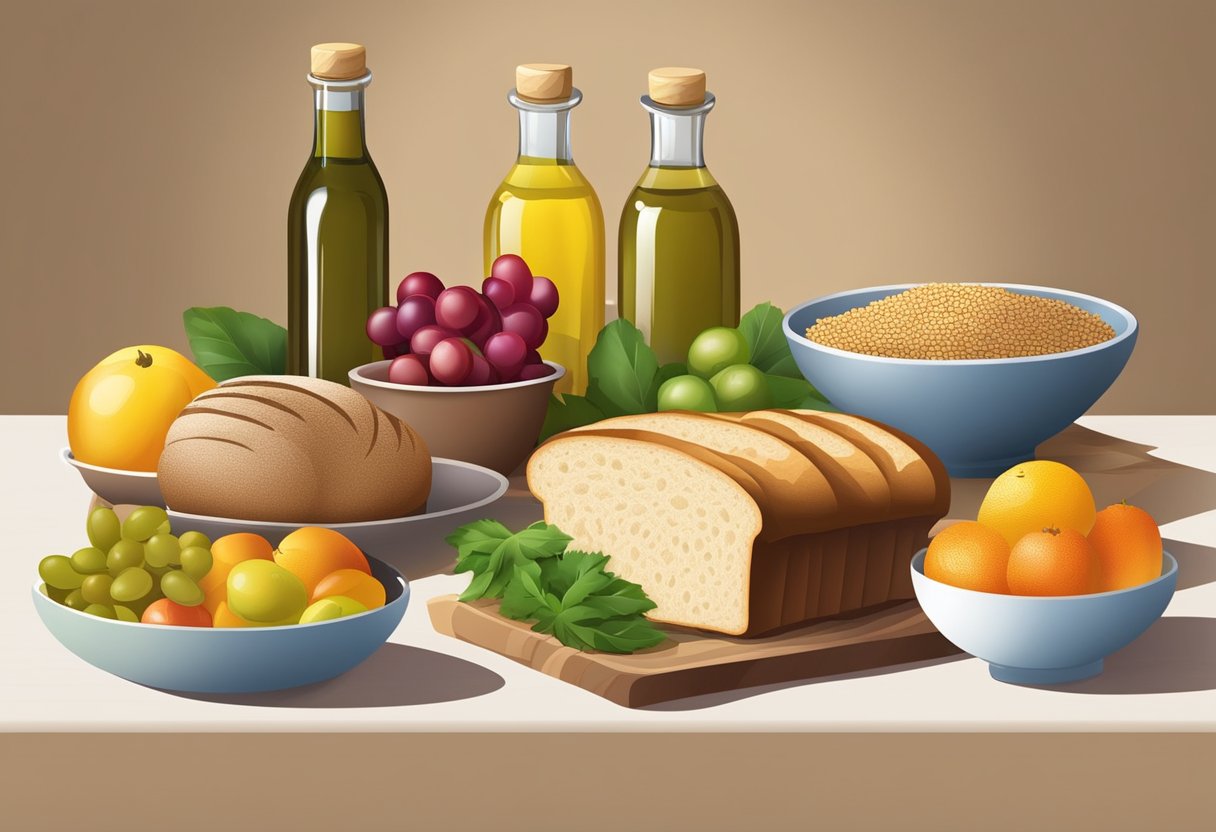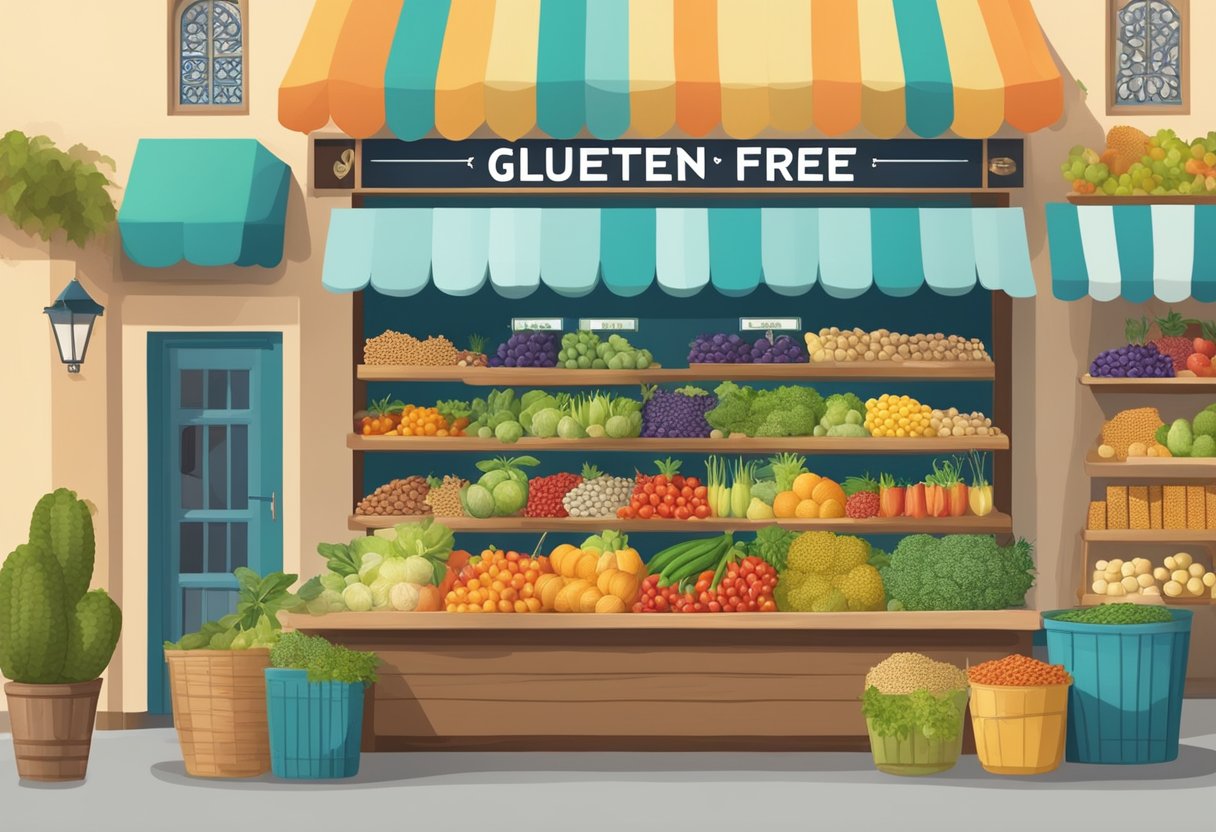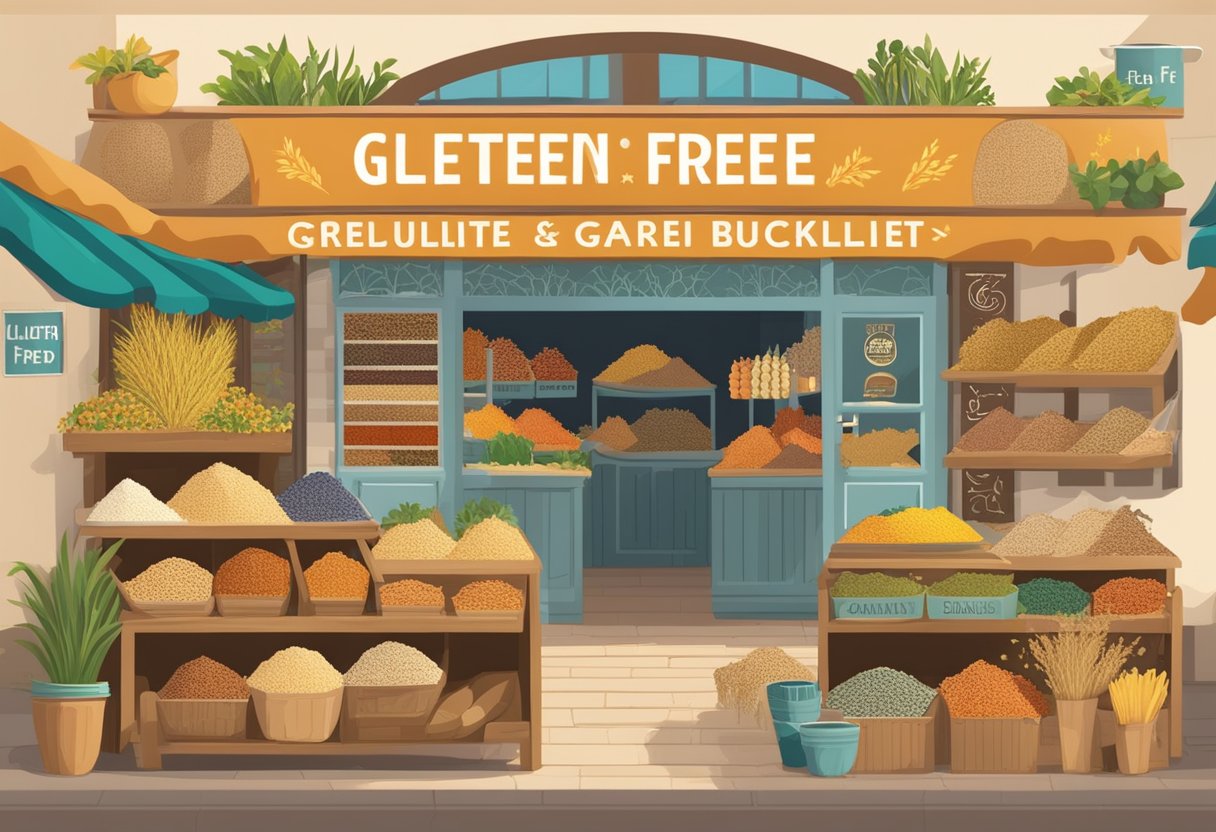Individuals with celiac disease or gluten sensitivity face the daily challenge of avoiding gluten, a protein found in wheat, barley, and rye. Adhering to a strict gluten-free diet is currently the only treatment for celiac disease and the most effective strategy for managing symptoms in those with gluten sensitivity. However, many gluten-free diets lack variety and essential nutrients. In response to this issue, the integration of the traditional Mediterranean diet with gluten-free eating has emerged as a beneficial alternative.

The Mediterranean diet is naturally rich in fruits, vegetables, legumes, nuts, and seeds, with moderate amounts of fish and poultry. These foods are inherently gluten-free and form the basis of a diet that is widely acknowledged for its health benefits, including its positive impact on cardiovascular health and potential to reduce the risk of certain cancers. By combining the Mediterranean diet with gluten-free requirements, individuals can enjoy a diverse and nutrient-rich diet while also addressing their health conditions.
Key Takeaways
- A strict gluten-free diet is essential for managing celiac disease and gluten sensitivity.
- The Mediterranean diet offers a nutritious framework for a well-balanced gluten-free lifestyle.
- Combining a gluten-free approach with a Mediterranean diet can provide varied and nutrient-dense eating options.
Table of Contents
Understanding Celiac Disease
Celiac disease is a chronic immune-mediated intestinal disorder precipitated by exposure to dietary gluten in genetically predisposed individuals. It involves a complex interplay between genetic factors and specific proteins found in wheat, rye, and barley.
Pathophysiology of Celiac Disease
The onset of celiac disease is triggered when individuals with a genetic predisposition consume gluten. The primary proteins in gluten, gliadin and glutenin, begin an immune response in the small intestine. This response is facilitated by two genes, HLA-DQ2 and HLA-DQ8, which are present in nearly all celiac patients. The immune system mistakenly targets the duodenal mucosa, leading to inflammation and a subsequent breakdown of the intestinal lining. Tissue transglutaminase, an enzyme, also plays a role by modifying gluten peptides, which then amplify the immune response.
Symptoms and Diagnosis
Symptoms of celiac disease can manifest as both gastrointestinal and non-gastrointestinal. Common digestive symptoms include diarrhea, bloating, and malabsorption, which can lead to nutrient deficiencies. For a definitive diagnosis, a combination of serology testing and an intestinal biopsy is typically used to look for specific antibodies and villous atrophy respectively.
Associated Health Risks
If left untreated, celiac disease can result in several associated health risks:
- Osteoporosis due to poor calcium absorption
- Anemia, commonly from iron deficiency
- Liver abnormalities and disorders
- Increased risk for certain types of cancer such as small intestinal adenocarcinoma and enteropathy-associated T-cell lymphoma
- Potential increased risk of heart disease due to chronic inflammation
Non-Celiac Gluten Sensitivity
Non-Celiac Gluten Sensitivity (NCGS) is a condition distinct from Celiac Disease, where individuals experience symptoms upon consuming gluten despite not having serological or histological markers of Celiac Disease. Addressing this sensitivity is crucial, especially within the framework of a Mediterranean diet, which already emphasizes minimally processed foods.
Diagnosing Gluten Sensitivity
The diagnosis of non-celiac gluten sensitivity typically occurs through the exclusion of Celiac Disease and wheat allergy. Since there are no specific serological markers, diagnosis heavily relies on patient symptom report and dietary response. Key steps include:
- Testing for Celiac Disease, including serology and intestinal biopsy, to exclude the disease definitively.
- Checking for wheat allergy to rule it out as a cause of symptoms.
- HLA-DQ2 or HLA-DQ8 genotyping as part of the diagnostic workup, although their absence does not exclude NCGS.
- Implementing a gluten challenge, where gluten is reintroduced after a period of abstention, often conducted in a double-blind, placebo-controlled manner to confirm sensitivity.
Symptoms Comparison with Celiac
| Symptom | Non-Celiac Gluten Sensitivity | Celiac Disease |
|---|---|---|
| Diarrhea | Often present | Usually present |
| Bloating | Common | Common |
| Abdominal Pain | Frequently experienced | Often experienced |
| Extra-intestinal Symptoms | May occur, including headache and fatigue | Can include dermatitis herpetiformis, anemia, and more |
Symptoms of NCGS may mimic those seen in irritable bowel syndrome (IBS) or, indeed, Celiac Disease. However, individuals with NCGS often experience symptomatic relief upon adoption of a gluten-free diet without the same intestinal damage seen in Celiac Disease. It is essential to differentiate between the two to ensure proper management and dietary adjustments within a gluten-free Mediterranean diet, aiming for a balanced intake of grains that are naturally gluten-free to alleviate symptoms.
Gluten-Free Diet Fundamentals

Adhering to a gluten-free diet is crucial for individuals with celiac disease or gluten sensitivity. It necessitates vigilance in avoiding all forms of gluten and potential contamination.
Gluten Containing Foods
The primary culprits in a gluten-rich diet are wheat, barley, and rye. These grains contain gluten proteins that can trigger harmful reactions in sensitive individuals. Oats, although naturally gluten-free, often come into contact with gluten-containing grains during processing and may pose a risk of contamination unless specifically labeled as gluten-free.
Common sources of gluten include:
- Breads
- Pastas
- Cereals
- Baked goods
For those following a Mediterranean diet, traditional staples like couscous and bulgur are also sources of gluten and should be avoided or replaced with gluten-free alternatives.
Reading Labels for Gluten
The accuracy of labeling is critical for ensuring adherence to a gluten-free diet. In the United States, the FDA mandates that foods labeled “gluten-free” must contain less than 20 ppm (parts per million) of gluten, which is a safe threshold for most people with celiac disease.
Key label-reading tips:
- Look for foods labeled as “gluten-free” or certified by reputable gluten-free organizations.
- Check for hidden sources of gluten such as malt, which is derived from barley, or additives like wheat starch.
- Be aware of statements like “manufactured in a facility that also processes wheat,” as it indicates a higher risk for gluten contamination.
- Understand that “wheat-free” does not necessarily mean gluten-free since other grains such as barley and rye also contain gluten.
Monitoring for gluten immunogenic peptides through testing products can also be beneficial for ensuring the absence of gluten proteins that cause immunological reactions in sensitive individuals.
The Gluten-Free Mediterranean Diet
The Gluten-Free Mediterranean Diet combines the heart-healthy principles of the traditional Mediterranean diet with the dietary needs of individuals with celiac disease or gluten sensitivity, emphasizing naturally gluten-free foods.
Core Components
Whole Grains: Integral to a gluten-free Mediterranean diet, whole grains like quinoa, buckwheat, and brown rice provide essential fiber and nutrients. They serve as the foundation for meals, ensuring a variety of vitamins and minerals while adhering to gluten-free restrictions.
- Quinoa: A versatile and nutritious grain, rich in protein.
- Buckwheat: Despite its name, it is a gluten-free seed that’s high in antioxidants.
Vegetables and Fruits: The cornerstones of this diet, an array of vegetables and fruits are consumed in abundance.
- Vegetables: Emphasizing variety and including leafy greens, root vegetables, and cruciferous veggies.
- Fruits: Prioritizing whole fruits over juices to retain dietary fiber and decrease sugar intake.
Legumes: These are important sources of protein and fiber, offering essential nutrients while also being naturally free from gluten. They can be included in salads, soups, or as a hearty base for entrees.
Fish: A staple in the Mediterranean diet, fish such as salmon, mackerel, and sardines are encouraged several times a week for their omega-3 fatty acids.
Olive Oil: Replacing other fats, olive oil is used generously for cooking and dressing dishes, contributing to the characteristic healthy fat profile of the diet.
Nuts: A source of healthy fats, fiber, and protein, nuts like almonds and walnuts are integral for snacks or as part of meals to add crunch and nutrition.
By thoughtfully selecting foods that are both naturally gluten-free and central to the Mediterranean diet, individuals can enjoy meals that are not only safe for their gluten-related conditions but are also flavorful and nutritionally balanced.
Nutritional Considerations and Supplementation

When individuals adopt a gluten-free Mediterranean diet, it’s essential to focus on maintaining the nutritional balance and managing possible deficiencies through strategic food choices and supplementation.
Maintaining Nutritional Adequacy
A gluten-free Mediterranean diet emphasizes fruits, vegetables, legumes, nuts, seeds, fish, and olive oil, which are naturally gluten-free and full of nutrients. However, individuals must ensure they consume a variety of these foods to meet their nutritional needs. It’s important to include sources of proteins such as legumes and lean meats, as well as a range of vitamins and minerals to support overall metabolism. Consuming a balanced variety of foods such as dark leafy greens and seafood can help maintain adequate levels of essential nutrients like iron, calcium, and zinc.
Supplements for Common Deficiencies
Individuals with celiac disease or gluten sensitivity can face deficiencies in certain nutrients due to malabsorption. Key supplements may be needed to compensate for these shortages:
-
Iron: Essential for blood production and can be deficient in a gluten-free diet. Consider iron supplementation if levels are low, alongside vitamin C to enhance absorption.
-
Calcium and Vitamin D: Vital for bone health, and their absorption can be impaired by celiac disease. Supplementation could be necessary, especially in low sunlight exposure regions.
-
Folic Acid: Important for cell production and often deficient in those with celiac disease. Enriching the diet with leafy greens or folic acid supplements can help.
-
Zinc: Supports the immune system and often found lacking in those on a strict gluten-free diet. Supplementation may be required to maintain optimal levels.
Remember, before starting any supplement, it’s recommended to check nutrient levels and consult a healthcare provider to tailor supplementation to individual needs.
Alternatives to Gluten-Containing Cereals and Grains

When managing celiac disease or gluten sensitivity, incorporating gluten-free grains and starches into one’s diet is crucial. These alternatives provide the foundation for a variety of nutritious dishes that align with a gluten-free Mediterranean diet.
Safe Grains and Starches
For those requiring a gluten-free diet, several grains and starches are safely consumable and can be incorporated into daily meals. Rice, a versatile staple, is naturally gluten-free and can serve as the base for a variety of dishes, from risotto to rice salads. Corn is another safe grain; it can be eaten as on the cob, popped as a snack, or used as flour in baking.
- Quinoa and buckwheat: These pseudocereals are not only free from gluten but are also packed with protein, making them excellent for salads, side dishes, or as a rice substitute.
- Certified gluten-free oats: While oats are inherently gluten-free, they are often cross-contaminated with gluten-containing grains during processing. Choosing certified gluten-free oats is vital to ensure safety.
Innovative Gluten-Free Products
The market for gluten-free products has expanded, offering convenient alternatives for those adhering to a gluten-free Mediterranean lifestyle.
- Breads and pastas: A wide range of gluten-free breads and pasta made from rice or corn flour are available, allowing consumers to enjoy these staples without worry.
- Breakfast products: Many breakfast options like cereals and granolas have been developed from gluten-free grains, ensuring a nourishing start to the day.
Gluten-free snacks are also easily found, ranging from rice cakes to corn-based tortilla chips, providing safe munching options throughout the day. Choosing products that are clearly labeled as gluten-free ensures that they meet the required standards and are free from cross-contamination.
Implementing the Diet
Embarking on a gluten-free Mediterranean diet requires careful planning and a commitment to meticulous label reading. To manage celiac disease or non-celiac gluten sensitivity, one must ensure that all aspects of the diet remain strictly gluten-free while incorporating the rich variety of foods typical of the Mediterranean way of eating.
Planning Gluten-Free Meals
When planning gluten-free meals, it is essential to include a variety of naturally gluten-free carbohydrates such as rice, quinoa, and corn. Meals should be balanced with a spectrum of colorful vegetables and fruits, which are core components of the Mediterranean diet. Opting for gluten-free grains ensures nutrient diversity without the risk of gluten contamination. For instance, incorporating gluten-free variants of staples like bread and pasta allows those with celiac disease to enjoy traditional Mediterranean dishes safely. For comprehensive meal planning, consulting a dietician can provide tailored advice and support long-term adherence to the diet.
Ensuring Gluten-Free Diet Adherence
Maintaining strict adherence to a gluten-free diet is the cornerstone of managing celiac disease. Regular follow-up with a healthcare professional helps to reinforce dietary guidelines and monitor any potential nutritional deficiencies. Safe food preparation practices are equally important, as cross-contamination with gluten-containing foods can occur. Label reading is a key skill that should be honed; individuals must be vigilant about checking ingredient lists for hidden sources of gluten. For those new to a gluten-free lifestyle, starting with a thoroughly vetted selection of foods can simplify the transition. Over time, expanding the diet while maintaining gluten-free integrity allows for greater variety and enjoyment without compromising on health.
Managing Health with a Gluten-Free Mediterranean Diet
Embracing a gluten-free Mediterranean diet involves strategic food choices to maintain health, particularly for those managing celiac disease or gluten sensitivity. This diet supports heart health and promotes beneficial gut microbiota, leveraging the nutritional value of naturally gluten-free foods.
Monitoring and Follow-Up
Follow-up with a physician or registered dietitian is essential after transitioning to a gluten-free Mediterranean diet. Regular monitoring ensures that the dietary needs for individuals with celiac disease or gluten sensitivity are being met effectively. It is also crucial to assess the diet’s impact on chronic illnesses such as heart disease and cancer.
- Checkpoints with healthcare providers should include:
- Evaluation of nutritional intake
- Healthy weight maintenance
- Symptom tracking
- Blood tests for nutrient deficiencies
Impact on Gut Microbiota and Overall Health
A well-executed gluten-free Mediterranean diet has a positive influence on the gut microbiota. This diet is rich in dietary fiber from sources like nuts and gluten-free whole grains, and these aspects of the diet facilitate the growth of health-promoting bacteria in the gut.
Specifically, the diet supports gut health by:
- Providing prebiotic fiber that fuels beneficial bacteria
- Encouraging the inclusion of probiotics through fermented foods, augmenting gut flora
This dietary approach offered by the Celiac Disease Foundation not only minimizes inflammation associated with celiac disease but also utilizes heart-healthy fats from nuts and oils, aligning with long-term health promotion and disease prevention.
Support and Resources
Individuals managing celiac disease or gluten sensitivity have several tools and allies at their disposal. Support can be found through dedicated organizations and professional advice tailored to navigate the gluten-free Mediterranean diet effectively.
Support Groups and Organizations
Support Groups play a pivotal role in daily management. They provide a platform for sharing experiences and learning from others who face similar challenges. The Celiac Disease Foundation offers comprehensive support, including a 7-day gluten-free Mediterranean diet meal plan, which is instrumental in the transition to and maintenance of a gluten-free lifestyle.
Community Resources are invaluable for connecting with local support groups and events. These resources often include access to educational materials and can be a bridge to finding nearby members of the gluten-free community.
Professional Guidance
A Physician should be the first point of contact for medical advice and diagnosis. They can validate the need for a gluten-free diet, oversee health progress, and provide referrals to specialists.
Dieticians with experience in managing celiac disease can offer structured advice on adopting a Mediterranean diet without gluten. Their expertise ensures that the diet remains nutritionally adequate while strictly excluding gluten-containing foods. Dieticians are essential in crafting meal plans that meet individual health requirements and preferences.
Frequently Asked Questions

Navigating a gluten-free Mediterranean diet raises many questions for those affected by celiac disease or gluten sensitivity. Here are direct responses to common inquiries.
What are some gluten-free options for a Mediterranean diet breakfast?
One can enjoy a variety of gluten-free breakfast options such as Greek yogurt with fruit and nuts, omelets with fresh vegetables, or quinoa bowls adorned with mixed berries.
Where can I find recipes suitable for a gluten-free Mediterranean diet?
Recipes that comply with a gluten-free Mediterranean diet can be found on websites like Celiac Disease Foundation which provides resources for gluten-free living.
Can individuals with celiac disease benefit from a gluten-free Mediterranean diet?
Certainly. Individuals with celiac disease can benefit from a gluten-free Mediterranean diet as it focuses on whole foods that are naturally free of gluten and emphasizes fruits, vegetables, lean proteins, and healthy fats.
How does a gluten-free Mediterranean diet differ from a standard Mediterranean diet?
The primary difference lies in the exclusion of foods containing gluten such as wheat, barley, and rye in a gluten-free version. The diet instead includes gluten-free grains like rice and millet.
What are the best resources for gluten-free Mediterranean diet meal plans?
One can find comprehensive meal plans for a gluten-free Mediterranean diet at UCLA Health which provides resources and specialist support for celiac disease.
Is it possible to dine out on a gluten-free Mediterranean diet, and how can I find suitable restaurants?
Yes, it is possible. Individuals can dine out on a gluten-free Mediterranean diet by selecting restaurants that offer gluten-free menu options or can accommodate dietary restrictions. It is advisable to research restaurants in advance and communicate dietary needs clearly to the staff.



